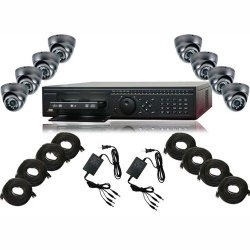 If you’re looking for a surveillance system that can also bring you “peace of mind” you should consider a digital camera security system. Burglar alarms are great for notifying you and others of an un authorized entry, but a digital camera security system can do that as well as document the unlawful event and identify the responsible party.
If you’re looking for a surveillance system that can also bring you “peace of mind” you should consider a digital camera security system. Burglar alarms are great for notifying you and others of an un authorized entry, but a digital camera security system can do that as well as document the unlawful event and identify the responsible party.
A digital camera security system is reasonably priced, versatile in application, and easy to install yourself, thanks to the tremendous technological improvements in just the last decade alone. Cameras are no longer big and bulky, analog systems have been replaced by more efficient digital devices, and the Internet is being used in a networking fashion never thought of by the digital video security industry 20 or more years ago.
A digital camera security system consists of one to several cameras, a Digital Video Recorder or DVR, and one or more monitors (after the system is set up the monitors are actually optional). These systems are component systems, meaning that your digital camera security system can be constructed from devices made by different manufacturers, or of different brands, or even different functional uses.
The ability to “mix and match” if you will, your digital camera security system’s components makes the system incredibly versatile in application and even less expensive in cost. For example, your design may require 8 cameras including one Pan-Tilt-Zoom or PTZ camera. It’s not necessary or required to purchase 8 PTZ cameras just for the sake of maintaining unity in type or manufacturer. This freedom allows you to purchase individual cameras (and other components) with specific functions so you can have a “tailor made” system designed specifically to meet your needs.
For the remainder of this article, we’ll take a look at two of the major components of digital camera security system, the camera and DVR to get a better understanding of the diversity and power of a component setup.
Cameras
The cameras used in a digital camera security system have one primary goal; to change a light image into an electronic image and submit it to the DVR for further processing. How it gets that electronic image varies but is based upon the use of one of two sensors that convert the light focused on them by the lens into electronic impulses.
The sensors used are either the Charged Coupled Device or CCD or the Complementary Metal Oxide Semiconductor or CMOS. Conveniently, both sensors are also sensitive to infrared light.
Some of the features, options, or special functions associated with the digital cameras can include:
- Total darkness video imagery using infrared illumination;
- The previously mentioned PTZ camera;
- Wide angle lens video;
- Motion detection and object tracking or following;
- License plate capture at high rates of speed;
- Hidden or disguised cameras;
- Wireless cameras;
- IP or Internet Protocol ready cameras;
- Explosion-proof cameras; and,
- Indoor or Outdoor cameras.
DVRs
While the cameras may be the “eyes” of a digital camera security system the DVR is equivalent to the brain of the system. The DVR performs several roles in the functioning of a digital camera security system but the main purpose of the DVR is to store or record the digital images sent to it by the camera. It does this by using a special utility called a CODEC (short for COmpression/DECompression) that shrinks the size of the file while maintaining high quality standards.
In addition to storing video files, DVRs are basically the control center for the entire digital camera security system. They coordinate the performance of all the different components including the cameras and monitors and usually are responsible for special devices as well.
Some of the features, options, or special functions associated with the digital cameras can include:
Some of the features, options, or special functions associated with the DVR can include:
- Camera controls, especially PTZ;
- Alerts and alarm notifications;
- Playback of recorded files;
- Web server technology enabling Internet communication;
- Camera capacity of 4, 8, 16, and 32;
- Audio input and output control;
- Network control and coordination; and,
- Record, playback, and streaming resolution.
As you can see, there can be a lot of activity in a digital camera security system, yet by using the component concept of construction these activities can all be handled or designed to the owner’s specification.











